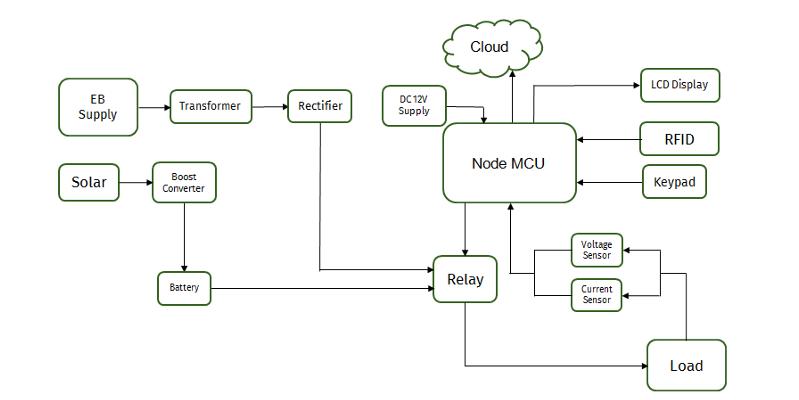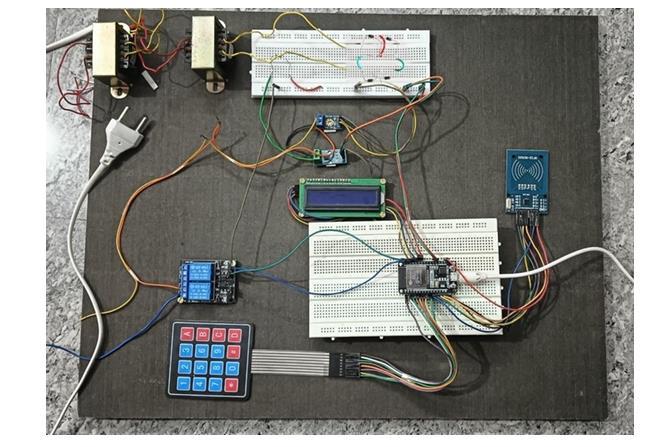
International Research Journal of Engineering and Technology (IRJET) e-ISSN: 2395-0056
Volume: 12 Issue: 02 | Feb 2025 www.irjet.net p-ISSN: 2395-0072


International Research Journal of Engineering and Technology (IRJET) e-ISSN: 2395-0056
Volume: 12 Issue: 02 | Feb 2025 www.irjet.net p-ISSN: 2395-0072
Dr.
S. M. Kannan (Prof & HOD / EEE)1 , Sivalingam R2, Somasundharam M3, Vel Murugan K4, Vishnu Kumar R D5
1 Prof & HOD/EEE,Department of Electricals &Electronics Engineering, K.L.N. College of Engineering, Tamil Nadu, India 2, 3, 4, 5UG Scholar, Department of Electricals & Electronics Engineering, K.L.N. College of Engineering, Tamil Nadu, India ***
Abstract - The main objective of the mini project is to develop the most efficient way to charge electric vehicles independently, without assistance from others. This mini projectpresentsthedevelopmentofasmart,advancedEV chargingsystemthatintegratesRFIDtechnologyforaccess controlandsolarpowerasanadditionalenergysource.With accessgranted,thissystemstreamlinesthechargingprocess for consumers, enabling them to charge their EVs conveniently.Customerswillbeissuedaccesscards,which they can use with the EV charging system to initiate the charging process. By placing the charging cable into the vehicle'schargingportandregisteringtheirattendancewith theaccesscard,theycanstartchargingseamlessly.
In addition, this EV charging system employs cloud technology to store customer data securely, allowing for efficientdatabasemanagementattheEVchargingstation. The cloud-based system supports real-time access and updates, ensuring smooth operation and data security for eachregisteredcustomer. During thechargingsession, an LCD display will show the amount due and the total time taken for the charge. Payment can be made through Net banking,Paytm,GooglePay,orPhonePay.Oncethepayment isreceived,thevehiclewillautomaticallystartcharging.The system will also notify the customer’s phone when the vehicleisfullycharged.ThisautomatedEVchargingsystem notonlypromotestheuseofcleanenergybutalsoenhances EVinfrastructure,reducesdependencyonfossilfuels,and significantlyimprovestheconvenienceandsustainabilityof chargingfacilities.
Keywords - RFID Tags and Reader, Communication Networks, Cloud Platforms, Mobile Application.
The transportation sector is undergoing a significant transformation,drivenbyconcernsaboutclimatechange,air pollution, and the depletion of fossil fuels. In response to thesechallenges,electricvehicles(EVs)haveemergedasa promisingsolutiontoreducegreenhousegasemissionsand reliance on traditional vehicles powered by internal combustionengines.
However, the widespread adoption of EVs faces several obstacles, including limited charging infrastructure, long chargingtimes,andtheneedforadvancedtechnologiesto facilitateseamlessintegrationinto existingtransportation systems. To address these challenges, the development of smartandadvancedenablingtechnology-basedEVcharging systems has become increasingly crucial. These systems leveragetechnologiessuchasRadioFrequencyIdentification (RFID) to enhance the efficiency, convenience, and accessibilityofEVcharginginfrastructure.RFIDtechnology, whichuseselectromagneticfieldstoautomaticallyidentify and track tags attached to objects, offers numerous advantages for EV charging systems, including secure authentication,real-timemonitoring,andautomatedbilling. This paper explores the concept of smart EV charging systems. It examines the key components, benefits, and applications of these systems, as well as their potential to accelerate the transition to a sustainable transportation ecosystem.
The major drawback of all the existing methodologies is more time consumption. To overcome this drawback, we usedfastchargeandadvancedsysteminthisprojectwhich haswiderangeprocessdependsontheelectricvehicles.To charge the Electric vehicle (EV) from charging station through EB, Solar power and Wind power by using RFID (RadioFrequencyIdentification)forAuthorizationpurpose andfutureimplementation.Thischargingsystemisclever.It candothingsliketrackhowmuchelectricityyourcarneeds, anditcanevencommunicatewithotherdevices.
The system uses Embedded System high-tech tools and cloudmethodstomakechargingyourcareasierandmore efficient.It'snotjustabasicplug-inand-chargesetup.This standsforRadioFrequencyIdentification.It'slikeaspecial kindofthingthatyourcarandthechargingstationuse to identifytheclientdetails.Whenyoucomeuptothecharging station, the consumer can phone to pay for charging your car.

Volume: 12 Issue: 02 | Feb 2025 www.irjet.net p-ISSN: 2395-0072
The system includes two main power sources: EB Supply (conventionalpowerfromthegrid)andSolarpower.TheEB supplygoesthroughaTransformertostepdownthevoltage and then a Rectifier to convert AC to DC for charging. Meanwhile, the solar power passes through a Boost ConvertertoincreasethevoltageandthenchargesaBattery, whichstoresenergyfordirectuseorasabackupwhenthe EB supply is unavailable. At the heart of the system is the NodeMCU(ESP32DevModule),amicrocontrollerwithWiFicapabilities.TheNodeMCUconnectstothecloud,which storescustomerinformation,usagelogs,andpaymentdata. Thisallowsforsecureaccess,datamanagement,andremote monitoring.Tostartcharging,theconsumerusesan11RFID cardtoauthenticateaccess.ThiscardisscannedbytheRFID reader,andtheauthenticationdata ischeckedagainstthe clouddatabase.
Foradditionalcontrol,thesystemalsoincludesaKeypad for input, like a PIN or account details if required. Once authenticated,theRelayistriggered,allowingcurrenttoflow to the EV load. The Voltage Sensor and Current Sensor monitorthepowerbeingsuppliedtotheEVandsendrealtimedatatotheNodeMCU,whichcanbedisplayedonanLCD Display.
The LCDalsoshowsinformationsuchas thechargingcost and time required. After charging, the system provides a billingsummary,andcustomerscanpayviadigitalplatforms like Net-banking, Paytm, Google Pay, or Phone Pay. When payment is received, the vehicle begins charging, and a notification is sent to the user’s phone once charging is complete.

Thepowersupplyisacriticalcomponentofeverycharging station,servingasthesourceofelectricalenergynecessaryto chargeelectricvehicles(EVs).Theprimaryroleofthepower supply is to supply electrical energy to the EV charging station. This energy is then transferred to the vehicle's batterythroughthechargingcableandconnector.Thepower supply's capacity, typically measured in kilowatts (kW),
determinesthemaximumchargingspeedthatthestationcan delivertoEVs.Higher-powersuppliesenablefastercharging, reducingthetimerequiredtoreplenishthevehicle'sbattery.
The Power Converter Unit (PCU) is an essential component in every EV charging station, responsible for convertingtheincomingalternatingcurrent(AC)powerfrom thegridintotheappropriateformneededtochargeelectric vehicles(EVs).
Intheconversionprocess,theACgridpowerfirstpasses through a step-down transformer that reduces the high voltage to a lower level suitable for the charging station, typically required for residential or commercial charging applications. This step ensures that the voltage level is compatiblewiththeEVchargingrequirements.
Afterstep-downtransformation,theACsupplyisdirectedto arectifier,whichconvertstheACpowerintoDCoutput.This DC output is then supplied to the EV's battery or to the onboardchargingunit,dependingonthechargingtype.
In DC fast charging stations, the PCU performs a more complexrolebyconvertingtheACgridpowerdirectlyinto high-voltage DC power compatible with the EV’s battery. UnlikeACchargingstations,whichrelyontheEV'sonboard charger to perform AC-to-DC conversion, DC fast chargers bypassthisstepandprovideDCpowerdirectlytotheEV’s battery.Toachievethis,thePCUinDCfastchargerstypically includes advanced power electronics, such as rectifiers, inverters, transformers, and voltage regulators, ensuring rapidchargingspeedsandhighefficiency.
Power converter unit plays several critical roles:
Voltage Conversion: Adjusting the voltage level of the incomingACpowertomatchtherequirementsoftheEV's chargingsystem.
Current Regulation: Controlling the amount of current suppliedtotheEVto prevent overloadingand ensure safe charging.
Power Factor Correction (PFC): Improving the power factor of the charging station to minimize reactive power consumptionandenhanceenergyefficiency.
DC to AC Conversion (Solar & Wind): Solar panels and windturbinesgeneratedirectcurrent(DC)electricity,which needs to be converted into alternating current (AC) to be compatible with the grid and EV charging equipment. The PCUperformsthisconversion,ensuringthattheelectricity generatedbyrenewablesourcescanbeusedtopowerthe charging stations and supply electricity to the grid if necessary.

Volume: 12 Issue: 02 | Feb 2025 www.irjet.net
The brains of the operation, the MCU governs the entire chargingprocess.Itreceivesdata,interpretscommands,and regulates power flow. A user-friendly interface that is calculate real-time information on charging status, battery percentage, estimated charging time, and potential error messages. An enhanced security feature utilizing Radio FrequencyIdentification
(RFID) tags for user authentication. The system can be programmed to recognize authorized users and initiate charging upon identification. This system incorporates renewableenergysourceslikesolarpanelsorawindturbine to generate electricity for charging. The MCU prioritizes renewable energy and seamlessly switches to grid power whennecessary.Thisinnovativeunitpreciselycalculatesthe remainingbatterypercentagebasedonthemeasuredvoltage andcurrent.ThisdataisthendisplayedontheLCD,providing valuableinsightstotheuser.Integratedsensorscontinuously monitorvoltageandcurrentlevels,ensuringsafeandefficient charging. The MCU utilizes this data to regulate power delivery and prevent potential damage to the battery remaining.Thisreal-timedataisdisplayedontheLCDscreen, allowinguserstoaccuratelygaugechargingprogress.This eliminatestheambiguityof"milestocharge"andprovidesa clearerunderstandingoftheremainingchargingtime.
The LCD display serves as the user interface, providing a plethora ofinformation.Itshowcasesthecurrentcharging status(percentageandestimatedtimeremaining),historical charging data, and any error messages. Additionally, the displaycanpresenteducationalcontentaboutEVcharging andsustainabilitypractices.
To display serves as an interface between the charging stationandtheuser.Itshowsreal-timeinformationsuchas the cost of the charging session, the amount of power deliveredtothevehicle,andtheestimatedtimeremaining untilthevehicleisfullycharged.Thisinformationhelpsusers make informed decisions about their charging needs and budget accordingly. Once the payment is successfully processedandreceivedbythechargingstation,thecharging session is initiated. The vehicle's charging system begins deliveringpowertotheEV'sbattery,graduallyreplenishing its charge. Users can monitor the progress of the charging sessioninreal-timeusingtheLCDdisplay.

First,inordertouthorizeconsumerstouseourEVcharging infrastructure, we have implemented an access control system.Consumersareissuedaccesscards.Thispromotes securityanduseraccountability byguaranteeing thatonly uthorizedindividualscanaccessthecharginginfrastructure. Usersonlyneedtotakethechargingcableandinsertitinto their vehicle's charging port to start the charging process once theyare givenaccess.Customers will havea flawless chargingexperiencethankstothissimpletechnique,which does away with the necessity for complicated setup processes. In addition, our charging system has an LCD display that shows consumers critical data in real time, includingthecostofthechargingsession,powerusage,and expected charging time. Users are able to make knowledgeabledecisionsabouttheirbillingbecauseofthis openness.
1.EnhancedSecurity:RFIDaccesscontrolsafeguardsagainst unauthorizedcharging.
2. Sustainability: Integration of renewable energy sources promotesecofriendlycharging.
3.UserConvenience:RFIDaccessandreal-timestatusdisplay ensureahassle-freeexperience.
4. Data-driven Optimization: IOT and cloud computing enabledatadriveninsightsforimprovedefficiency.
5. Remote Management: Centralized monitoring facilitates proactivemaintenanceandsystemupgrades.

International Research Journal of Engineering and Technology (IRJET) e-ISSN: 2395-0056
Volume: 12 Issue: 02 | Feb 2025 www.irjet.net p-ISSN: 2395-0072
ThissmartandadvancedEVchargingsystempavestheway forasustainableanduser-centricfutureofelectricmobility. ByincorporatingRFIDaccess,renewableenergyintegration, real-time monitoring, and a user-friendly interface, this system caters to the evolving needs of EV owners and charging station operators. As technology continues to advance,furtherintegrationofAIandmachinelearningcan unlockevengreaterpotentialforintelligentanddynamicEV charging solutions. Additionally, Integrates the Cloud databasesystemtostoreandmanagecustomerdata.This cloud-basedsolutionenablessecurestorageandeasyaccess toconsumerrecordsatanytime,facilitatingasmoothand automatedtransactionprocess.
Wethankourmentorsandadvisorsfortheirguidance,and our institution for providing the necessary resources. Our peers and colleagues also played a key role through their collaborationandsupport.Weappreciatethecontributions of industry experts and research references that helped shapeourproject.Lastly,wearegratefultoourfamiliesand friendsfortheirconstantencouragementandmotivation.
SDG7:AffordableandCleanEnergy
The use of renewable energy systems for electricity generation, helps in maintaining clean energy which is affordable at minimum cost and irrespective of location constraints.
SDG8:Decentworkandeconomicgrowth
Thereplacementoffossilfuelsbyrenewableenergysources reducestheimportofoilandimprovescountries'economic development.
SDG9:IndustryInnovationandInfrastructure
Thisinnovativeelectricchargingmethodrequirestheneed forsmartinfrastructureforelectricchargingstations,which willboosttheentrepreneursforsettingupsuchstationsin citiesandremoteareaswithsophisticatedinfrastructure.
[1]2020, International Journal ofResearchand Analytical Reviews(IJRAR)IJRARSeptember2020,Volume7,Issue3A. Ajithkumar, M. Ajithkumar, S. Gopi, V.G. Balajisabarinathan, Mr. C. Gowrishankar “Department of ElectricalandElectronicsEngineering,PaavaiEngg.College, Namakkal, India” titled as SMART E-VEHICLE CHARGING SYSTEMUSINGRFID.
[2]2023, International Journal ofResearchand Analytical Reviews(IJRAR)IJRARVolume13,Issue06,Jun2023titled asRFIDSOLARCHARGINGSTATIONFOREV.
[3] 2024, International Journal Of Creative Research Thoughts(IJCRT)Volume12,Issue5May2024-Goutham KrishnaCM,HarikrishnanCN,SidharthPV,IrfanKN, Baby V “Computer Science and Engineering Department, Nehru College of Engineering and Research Center (NCERC), Thrissur,India”titledasEVSMARTCHARGINGSYSTEM.
[4] 2022,InternationalResearchJournalOfEngineeringand Technology(IRJET)Volume09,Issue04,Apr2022-Revath BC,TanmayeeR,PrashanthCVeeru,NuthanBS,VishwasK Singh, Gowtham B “Dept. of Electronics and Communications,VVCE,Mysore,KarnatakaIndia”titledasA REVIEWONELECTRICVEHICLECHARGINGSYSTEMS.
[5]2020,JournalOfEmergingTechnologiesandInnovative Research(JETIR)Volume07,Issue04,April2020–Avinash V.Shrivastav,SajidhussainS.Khan,RahulK.Gupta,PrajktaR. Ekshinge,ParmeshwarSuryawanshi“Student,Department of Automobile Engineering, Lecturer, Department of Automobile Engineering, 1Marathwada Mitra Mandal’s Polytechnic, Thergaon, Pune, India” titled as ELECTRIC VEHICLECHARGINGSTATION.
[6]2021,InternationalJournalOfResearchPublicationand Reviews (IJRPR) Volume 02, Issue 03, 2021 – Aishwarya Gajanan Bille, Yashashri Rajaram Patil, Vikram B Patil “Department Of Electrical Engineering, Ashokrao Mane Group of Institutes, Kolhapur, India” titled as REVIEW PAPERONCHARGINGOFELECTRICALVEHICLE.
[7] 2023, Iconic Research and Engineering Journals (IRE Journals)Volume06,Issue11,May2023-Gowresudarshan Ashok, Vikas, Sindhu Reddy, Abinezer, T. Vinay Kumar “DepartmentofElectricalandElectronicsEngineering,Guru Nanak Dev Engineering College, Bidar, Karnataka, India” titledasWIRELESSELECTRICVEHICLECHARGINGSYSTEM.
[8] 2024, International Journal of Advanced Research in Science,CommunicationandTechnology(IJARSCT)Volume 04,Issue02,March2024-Mr.BhosaleChetanMachhindra, Mr.DawangeShubhamJijahari,Mr.BhangadeRRatan,Mr. Sonawane Mayur Ramesh, Prof. Yeole S. S., Dr. P. C. Tapre “Department of Electrical Engineering6 S. N. D College of Engineering&ResearchCenter,Yeola,Maharashtra,India” titledasRFIDBASEDEVCHARGINGSTATION(SOLAR)